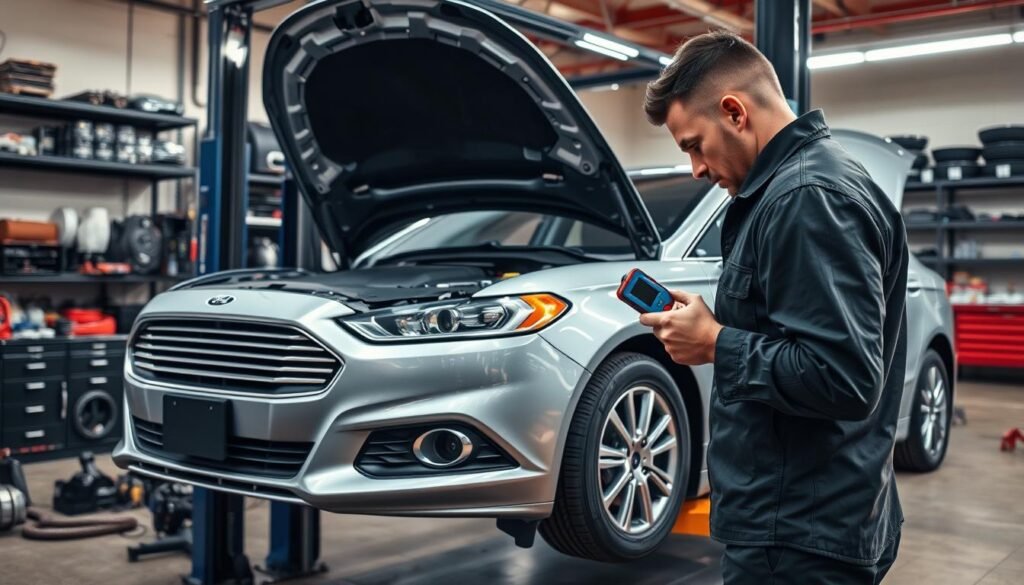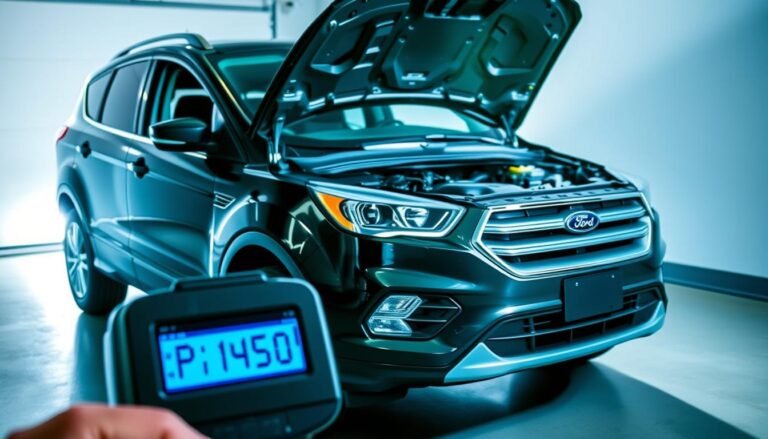Ford Fusion Common Problems & Reliability Issues
The Ford Fusion, available from 2005 to 2020, has been a reliable car for many. However, it’s good to know about some common problems.
These issues can affect how well your car runs. Knowing about them helps with car care and making wise choices, whether you have a Fusion or think about buying one.
We’ll cover different troubles Fusion owners might face, like electric issues, steering problems, and trouble with the transmission.
You’ll learn about issues more common in certain years too. Plus, we’ve got tips to fix these issues fast and well. Learning about the Fusion’s reliability issues helps you protect your car.
With this info, you can keep your Fusion running well. Let’s dive into the typical issues to keep you driving without worries!
Introduction To The Ford Fusion
The Ford Fusion came out in 2005. It was a stylish, mid-size car designed for both flexibility and comfort.
It mixed good looks with function, drawing in different kinds of buyers. The roomy inside was a big plus for families and workers.
Plus, the choice of regular or hybrid engines caught the eye of those who care about the planet. From start to finish in 2020, the Fusion changed to meet what people wanted.
It was known for being good on gas and easy to use. Ford brings it back with new features, aiming at SUV and truck lovers but keeping sedan fans happy.
Knowing the Ford Fusion’s strengths and weaknesses helps owners. This makes it easier to take care of the car.
| Model Year | Key Features | Engine Options | Fuel Economy (MPG) |
|---|---|---|---|
| 2005 | Standard mid-size features | 2.3L I4, 3.0L V6 | 20/29 |
| 2015 | Enhancements in technology | 2.5L I4, 1.5L Turbo I4, 2.0L Turbo I4 | 22/34 |
| 2020 | Final year; hybrid options available | 2.5L I4, 2.0L Turbo I4 | 43/41 |
Overview of Ford Fusion Models
The Ford Fusion has moved through two main generations from 2006 to 2020. The first generation spanned 2006 to 2012.
It introduced various Ford Fusion models with different engines, like four-cylinder and V6 options. There were three main trims: S, SE, and SEL.
They each had unique features and performance levels. Plus, there were hybrid options for those looking to save fuel.
The second generation ran from 2013 to 2020. It brought new engine technology, especially the EcoBoost engines.
This period focused on modernity, adding better tech and safety features. Every model year had something new, reflecting tech advances and changing consumer needs.
This resulted in a wide range of Ford Fusion trims tailored for different preferences. Both Ford Fusion generations have their own special qualities.
Knowing these differences can help you pick the best model for your needs and taste.

| Generation | Model Years | Key Features | Engine Options | Main Trims |
|---|---|---|---|---|
| First Generation | 2006 – 2012 | Variety of body styles, hybrid options | Four-cylinder, V6 | S, SE, SEL |
| Second Generation | 2013 – 2020 | Advanced tech features, improved safety | EcoBoost, hybrid | S, SE, Titanium |
Ford Fusion Common Problems
Ford Fusion cars often face various issues that can affect their performance and reliability. Catching these problems early can save a lot of money on repairs.
We’ll look into three main problems: electrical system glitches, power steering failure, and transmission troubles.
Electrical System Malfunctions
Ford Fusion’s electrical system issues are frequent, especially in older models. Problems can include faulty CD players or backup cameras that don’t work.
Newer models have better technology, but the early ones may have more electrical problems. Spotting these signs early can help fix issues before they get worse.
Power Steering Failures
Power steering issues are especially common in Fusions made from 2010 to 2016. Drivers have reported suddenly losing the ability to steer.
This can seriously affect the car’s control and your safety. If steering feels hard or doesn’t respond, getting it checked quickly is important for safety.
Transmission Issues
Transmission problems are also a big worry for Ford Fusion owners, particularly in models from 2013 to 2019.
People have noticed transmission problems like rough shifting or delays. Leaks can make these problems worse, causing more damage.
Checking your transmission regularly helps avoid long-term issues and keeps your car running smoothly.
Notable Ford Fusion Reliability Concerns
The Ford Fusion is known for being reliable. But some models from 2007, 2008, 2010, 2011, and 2013 have issues.
These particular years are known for more frequent problems. These issues can impact both the car’s performance and safety.
Drivers have reported problems with airbag deployment, which is a big safety risk. Faulty throttle bodies are also a problem, and they can mess up the engine’s performance.
Also, leaks in the engine coolant can lead to overheating. This means expensive repairs and less reliability.
Knowing about these issues can help buyers and owners make better choices about their cars.
By looking into these concerns, you can better understand the risks and benefits of a Ford Fusion.

Reported Defects in Specific Ford Fusion Models
It’s key for both potential and current Ford Fusion owners to know about the model’s problems.
Some years have more issues than others. We will look at the common problems and recalls.
Common Defects From 2006 To 2012
Models made between 2006 and 2012 had some big problems. Issues that were often reported include:
- Braking system failures that affect stopping ability
- Interior component malfunctions, such as faulty dashboard displays
Several recalls have been made to fix these safety concerns and make owners happy.
Issues with Models From 2013 To 2020
The 2013 to 2020 models had more complicated issues. The problems reported include:
- Electrical system failures leading to operational interruptions
- Unexpected engine stalling while driving, posing safety risks
- Transmission faults, affecting performance and handling
These problems led to big recalls, especially for safety parts like airbags and power steering. Buyers should carefully check these issues before buying.

Troubleshooting Tips For Ford Fusion Owners
Facing problems with your Ford Fusion can be simpler than you think. Recognizing the issue is the first key step for a quick fix. We’ll cover how to deal with steering problems and electrical glitches.
Addressing Steering Problems
Begin by inspecting your power steering pump for signs of wear. Trouble in steering? It could mean your pump is bad or you’re low on fluid.
Here’s what to do next:
- Check the power steering fluid and watch for leaks.
- Listen for odd noises from the power steering pump.
- Fix any worn parts or update the software if needed.
Resolving Electrical System Issues
Fixing your Ford Fusion’s electrical issues starts with basic steps. Make sure your battery’s connections are tight. Then, use diagnostic tools to find any problems.
Here’s what else you can do:
- Ensure the battery is charged and clean the terminals.
- Use diagnostics to identify any error codes.
- Check Ford’s guidelines for any software updates.

Maintenance Problems in Ford Fusion Vehicles
Keeping your Ford Fusion in good shape needs you to focus on some key areas. If you ignore regular checks, you might face big problems later.
Look closely at the fluids, brakes, and electrical parts, as they are vital for your car’s well-being. Brakes tend to wear out quickly, and ignoring them can cause transmission issues.
Regular oil changes keep your engine running smoothly. It’s also smart to keep an eye on your brakes and fluid levels for the best performance.
Checking tire pressure is important for saving gas and staying safe on the road. Taking care of your car’s maintenance needs on time helps avoid bigger, expensive repairs later.
A regular maintenance routine makes your Fusion last longer and work better.
Ford Fusion Performance Issues
Ford Fusion owners might face various performance problems linked to how much the car has been driven. Knowing how mileage affects your car’s performance is key.
It helps you take care of your car, keeping it running smoothly. Regular checks and repairs are important to keep it performing well, as parts wear down over time.
Impact of Mileage on Performance
As your Ford Fusion gets driven more, its performance may drop. This drop can mean less power and slower acceleration.
The engine, transmission, and exhaust systems often get affected first. Monitoring your car’s mileage lets you know when it’s time for maintenance to keep it efficient.
Maintenance and Performance Improvement
Keeping up with your Ford Fusion’s maintenance schedule can really help its performance. Early checks can spot issues before they get worse.
Important steps include:
- Conducting timely oil and fluid changes.
- Replacing air filters and spark plugs when necessary.
- Checking tire pressure and alignment for better control.
- Taking care of small fixes to avoid bigger ones later.
Seeing a big drop in how your car runs means it’s time for a professional to look at it. A certified mechanic can find what needs fixing to get your car back to its best.
Conclusion
The Ford Fusion is still a good choice for a mid-size sedan, despite its problems over time. Knowing about issues in early models helps make smart buying and upkeep decisions.
Being aware of electrical, steering, and transmission problems leads to a smoother ownership experience.
Maintaining your Ford Fusion well and fixing issues quickly boosts its reliability and performance.
Many owners see their Ford Fusions last longer than expected when they take good care of them. This makes the car a trustworthy option for everyday use.
To sum up, both future buyers and current owners should focus on taking good care of their car.
Knowing about your vehicle helps you enjoy driving it more and keeps it running well for a long time.
FAQs
Q: What are the most common problems reported in Ford Fusion vehicles?
A: The main issues are with electrical systems, power steering, and the transmission. There are also reports of failing CD players and backup cameras, especially in older models.
Q: Which model years of the Ford Fusion have the most reliability concerns?
A: The 2007, 2008, 2010, 2011, and 2013 models have the most problems. These include airbag deployment issues and coolant leaks.
Q: How can I troubleshoot electrical system issues in my Ford Fusion?
A: First, check the battery connections and run a diagnostic test. Updating your software as Ford suggests can also prevent issues.
Q: Are there specific defects to be aware of in older Ford Fusion models?
A: Yes, models from 2006 to 2012 often have brake and interior problems. Models from 2013 to 2020 usually face electrical issues and engine stalling.
Q: What maintenance problems should I watch for in my Ford Fusion?
A: Skipping routine checks on fluids, brakes, and electrical systems can lead to problems. It’s crucial to change your oil and check your brakes regularly.
Q: What impact does mileage have on the performance of my Ford Fusion?
A: Vehicles with higher mileage might lose power and not accelerate as quickly. Keeping up with inspections and maintenance can help your car perform better and last longer.
Q: What solutions are there for power steering failures in Ford Fusion models?
A: Checking the power steering pump and components for wear is a good first step. Sometimes, updating the software can fix the issue. If parts are worn out, they may need replacing.







